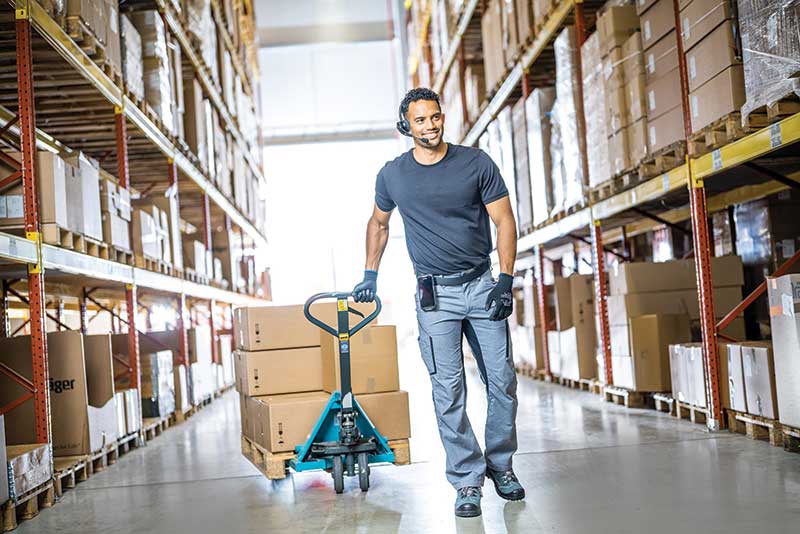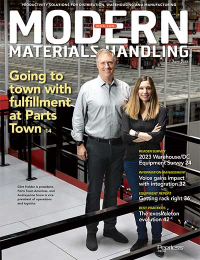Voice picking solutions gains impact with integration
Voice-directed solutions do more than translate pick lists in voice instructions. These solutions are multi-modal, using wearable scanners and Android device screens when appropriate, and have evolved to handle work execution functions and integrate with mobile robots.

Voice picking solutions are well proven in the market, prized for keeping frontline workers hands-free and focused on fast and accurate order picking with voice-based directives. But voice solutions today do more than turn pick lists into audible instructions. These systems function as fulfillment solutions that may use multi-modal inputs and are capable of integrating with different systems.
For years now, voice solution vendors have incorporated wearable bar code scanners as an input to their systems and some are able to coordinate voice-directed workflows with autonomous mobile robots (AMRs). Voice adds value on its own, but don’t be surprised if you see a voice-directed system working in concert with mobile robots, or for that matter, with fixed automation like conveyor, because they already do.
Numina Group, for example, has deployed voice and AMRs working together to fill orders, using the voice-directed work module of its RDS warehouse execution system (WES) software, as well as logic in the WES that co-manages the movements of AMRs and associates picking by voice. Dan Hanrahan, CEO of Numina Group, says Numina’s RDS BatchBot solution manages order release and cartonization, the tasks and movements of the AMRs, as well as the pickers’ movements and picks, as an integrated application.
Instead of pushing along a cart, RDS BatchBot workers use voice to pick to a shelf or rack on an AMR; and when a set of picks is complete, the AMR can take the goods downstream. The system will then direct the picker to meet the next nearest AMR ready to facilitate more picking.
“It’s very similar to what we’ve done in voice picking in a pick module where we have people working within zones and orders flowing to them,” says Hanrahan. “We’re doing very much the same process in a voice-directed picking application with AMRs where the tasks for the AMRs and the people are united together within the same software application.”
Another major change from voice solution vendors are enhanced voice recognition engines that do away with the need to “train” the system to recognize each new worker’s voice.

Ron May, senior solutions consultant with Lucas Systems, which offers its Jennifer voice solution and software for warehouse execution, says speech recognition advances make it possible to quickly onboard new associates, making voice a solution well matched to today’s high turnover rate in warehousing.
“All those hundreds of millions of dollars that the big tech companies like Google, Microsoft and Apple have put into voice recognition have helped make voice platforms we use in the warehouse better and more robust,” says May. “You can onboard new workers faster, because the voice recognition platform we have is speaker independent, so a new person can just pick up a headset, put it on, and they’re off and running. These advances have helped increase the adoption of voice, especially in industry segments that have high turnover. And, once a new user is on the system, the other thing we add is the ‘Ask Jennifer’ capabilities to make the system very user friendly.”
Integration points
Voice solutions have evolved in some deployments to integrate with systems like conveyor controls, and similarly, a voice system can integrate with mobile robots used for materials transport, adds May.
Such integrations are ideally done on a systems level, says May, so the voice system communicates the completion of work to a warehouse management system (WMS) and other systems linked to the WMS, such as a conveyor control system.
“That type of integration can happen automatically, behind the scenes, as part of work orchestration, rather than putting a burden on the voice user of having to know where a tote needs to go next,” says May.
Over the years, adds May, voice solutions have also become more multi-modal, using wearable bar code scanners in many deployments, especially for capturing lot or serial data that might be on a bar code. However, for many functions such as picking, voice instructions and short “check digit” replies to confirm details like location are typically the most time efficient, says May.

“At the core of it, voice is a very intuitive user interface, and time efficient, too, because workers can be hands free and eyes free as they execute tasks,” says May “In some situations, a scan might be the quickest way to capture certain data, but generally, voice-directed work carries inherent productivity benefits by keeping workers hands-free and eyes-free as they execute tasks.”
When it comes to AMRs and voice working together, says Hanrahan, the best benefits come from synchronizing AMR movements with pickers. “We cut down walking and wasted movement tremendously by integrating them both into the same application,” says Hanrahan.
Numina’s combining of voice and AMRs was accelerated by a solution it devised for NorthShore Care Supply, an Illinois-based distributor of adult diapers, whose use of the blended technologies was featured in Modern’s September 2020 cover story.
Numina’s voice and AMR functionality can also be applied to mixed-case pallet picking, with workers outfitted with voice picking to pallets on large AMRs, says Hanrahan. Smart robotic sort walls are another newer technology that could be blended with voice.
“There is just a wealth of different technologies that we can combine together based on the application requirements,” says Hanrahan. “A differentiator for us is that we’re not just selling AMRs, and not just voice, but an integrated solution that may combine people, voice and mobile robots working together.”
Labor savings
Across many processes, voice-directed solutions cut down on selection time at the point of task because of the hands-free and eyes-free nature of the technology, notes Scott Deutsch, president of EPG Americas, a global provider of supply chain execution software and its Lydia voice solution.
Deutsch says a handful of companies that use Lydia are studying the potential of combining voice with mobile robots. There’s potential there, he adds, because AMRs excel at automating materials transport or with assistive-picking AMRs, reducing travel time for pickers. “When you think about it, mobile robots are really good at reducing non-value-added travel in a warehouse, while technology like Lydia Voice gives you productivity at the pick location,” says Deutsch.
One of the top drivers for deploying voice, Deutsch adds, are companies that deployed enterprise resources planning (ERP) and WMS to avoid the Year 2000 computer problem, and now many are migrating to newer Cloud-based ERP and WMS solutions and want to maximize the software refresh by adding voice to WMS.
“We’re seeing a dramatic growth in our business around organizations going through major ERP and WMS upgrade cycles,” Deutsch. “Voice is seen as part of the upgrade project and process improvement effort, not an afterthought.”
In addition to speeding up picking processes, says Deutsch, voice-directed solutions can also help accelerate stocking or replenishment workflows.
Deutsch also agrees another evolution in voice: improved voice recognition engines speed up onboarding. EPG uses deep neural network technology in its recognition engine to eliminate the need the need to “train” the system on a new worker’s voice, and also has expanded on the languages Lydia can recognize, including language combinations like Spanglish.
“The trends with voice all come back to labor challenges and labor productivity in some way. Right now, a top driver we’re seeing the extremely high turnover rate many operations are facing,” Deutsch says. “That makes the ability of a voice solution to get workers up to speed quickly, regardless of their language or dialect, absolutely paramount.”
Work execution capabilities
Keith Phillips, president and CEO of Voxware, a provider of voice solutions and work execution software, says a couple of Voxware’s clients have piloted mobile robots, but to date none have used AMRs in concert with Voxware’s voice solution, though it would be possible to use AMRs to transport totes or orders picked by voice.
“For us, interacting with a mobile robot would not be much different than interoperating with something like an intelligent pallet jack, which we can do through our work execution capabilities,” says Phillips. “It’s one of those things where we’re ready for the market, but not that much of the market is quite yet ready for robotics.”
Phillips agrees that improved voice recognition technology is one of the most impactful trends for voice-directed applications, in that most are struggling with high turnover. With Voxware’s natural language voice recognition engine, there is no pretraining the system for a new user’s voice—just a brief tutorial and a new associate can start being productive.
“That’s been a game-changer for our customers because it allows them to navigate the dynamics of today’s workforce more effectively,” says Phillips.
Most voice solution vendors have also expanded into work execution functions, notes Phillips, which adds software capabilities like containerization, order release and picking logic, cycle counting, or kitting, which might be more advanced than what some WMS or legacy WMS solutions can support. In this sense, voice solutions have evolved to drive the execution of fulfillment processes and “fill gaps” that might be lacking in a WMS, Phillips explains.
“We have the capability to manage multiple processes, from receiving all the way through truck loading, through work execution capabilities,” says Phillips. It’s not just voice picking of small items, but everything from pallet building to something as intricate as how you should fold a piece of apparel to pack it. Then we layer analytics on top of all these functions to find further areas for improvement. Voice has certainly evolved to be more than voice picking. Today it’s multi-modal in the devices that can be used, with work execution capabilities to accelerate multiple processes.”

Article Topics
Ehrhardt Partner Group News & Resources
Automatic data capture (ADC): Accelerating the process Voice picking solutions gains impact with integration EPG appoints new CEO for Americas EPG’s new voice solution gains certified by SAP statusLatest in Materials Handling
Hyster recognizes Dealers of Distinction for 2023 Carolina Handling names Joe Perkins as COO C-suite Interview with Keith Moore, CEO, AutoScheduler.AI: MODEX was a meeting place for innovation Walmart deploying autonomous lift trucks at four of its high-tech DCs Coles shops big for automation Kathleen Phelps to join FORTNA as chief financial officer Coles automates grocery distribution in Australia More Materials HandlingAbout the Author
Subscribe to Materials Handling Magazine

Find out what the world's most innovative companies are doing to improve productivity in their plants and distribution centers.
Start your FREE subscription today.
April 2024 Modern Materials Handling

Latest Resources











